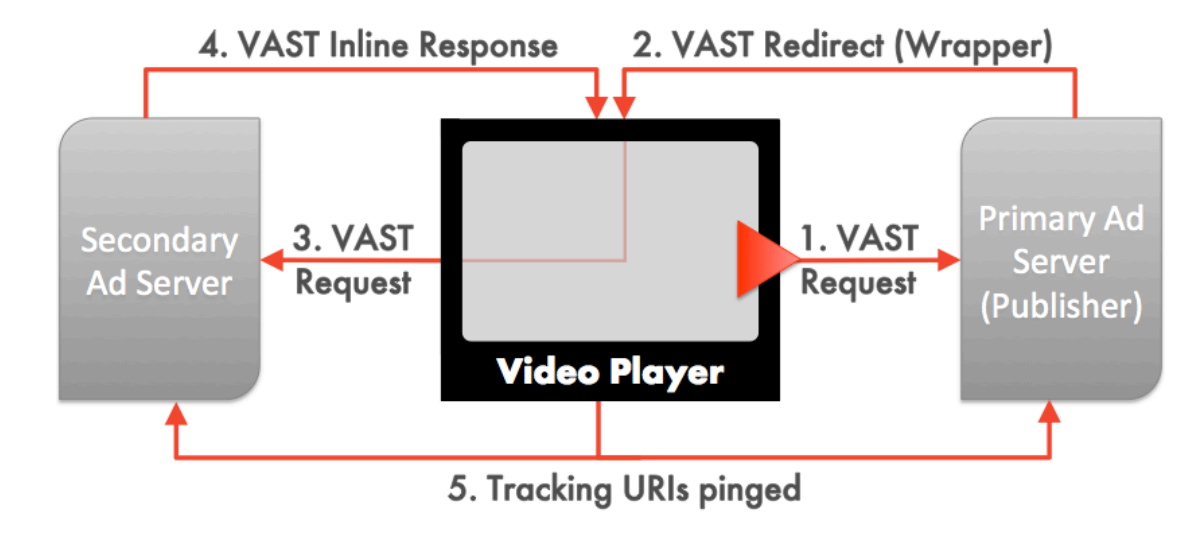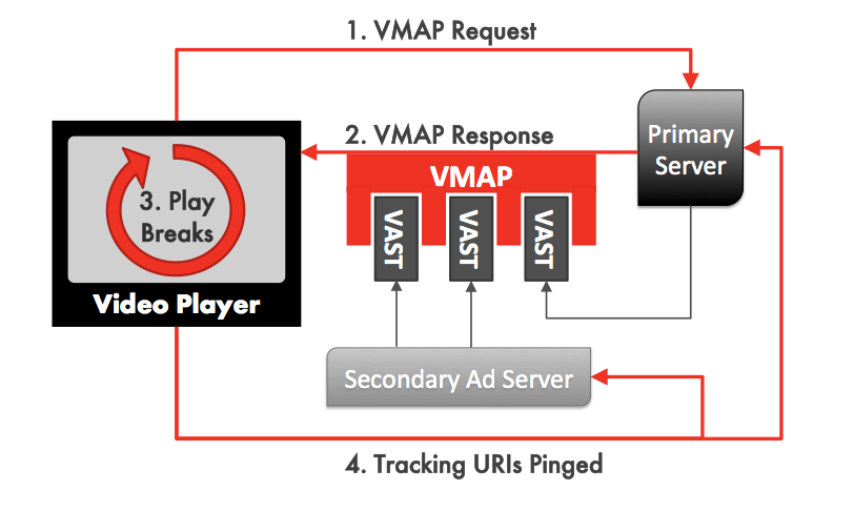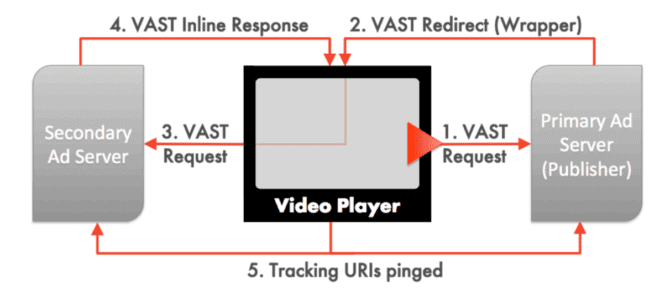The VAST, VMAP, and VPAID video ad standards ensure smooth ad delivery, proper tracking, and seamless integration across platforms in digital video advertising, as well as interactive advertising. This article provides a brief overview of what these standards are and how they work together.
Contents
Section I: Ad Serving Standards
1. Video Ad Serving Template (VAST)
VAST is the standard format ad servers use to deliver ads and related information to players and servers that display those ads. Developed by the Interactive Advertising Bureau (IAB), it facilitates ad delivery across different video players and devices.
Key Components of VAST:
- Ad Tag: The URL that returns the VAST XML response.
- Inline Ad: Contains all necessary assets and tracking pixels within the VAST XML.
- Wrapper Ad: This point to another VAST tag, enabling multi-source ad delivery. The ability to request ads from multiple ad servers or networks increases the likelihood of filling each ad slot and potentially boosts revenue. See Entities Involved below.
- Creative: The ad content (video file, companion banners, etc.).
- Tracking Events: Pixels fired at specific points during ad playback (start, first quartile, midpoint, etc.).
- Error Reporting: Mechanism to report issues in ad delivery or playback.
Tracking Pixels in VAST:
Tracking pixels are small, invisible images embedded in the VAST response. They measure ad performance and user interaction. When certain events occur during ad playback (e.g., start, complete, click), these pixels are “fired,” sending a request to a server and logging the event. This allows advertisers to track impressions, completions, and other important metrics.
For a more detailed explanation of tracking pixels, see our separate article: Understanding Tracking Pixels in Video Advertising.
Evolution of VAST Versions:
- VAST 1.0 & 2.0: Basic video ad serving.
- VAST 3.0: Added support for skippable ads and ad pods.
- VAST 4.0: Introduced support for server-side ad insertion (SSAI) and improved error reporting.
- VAST 4.1 and 4.2: Enhanced support for interactive ads and improved verification.
How VAST Works
The Interactive Advertising Bureau (IAB) outlines a detailed procedure for ad insertion using VAST. Below is the step-by-step process:

- VAST Request: The video player sends a request to the primary ad server, usually the content owner/publisher.
- VAST Redirect: During campaign setup, the advertising party (possibly an agency or network) provides a VAST “Wrapper” that acts as a redirect to a video ad server.
- VAST Request: The video player then requests the video ad from the secondary ad server.
- VAST Inline Response: The secondary ad server sends the video ad formatted in a VAST response.
- Tracking URIs Pinged: Upon triggering specified events for the ad, each ad server is notified using the tracking URIs provided in the VAST response.
2. Video Multiple Ad Playlist (VMAP)
VMAP is another IAB standard that complements VAST. While VAST defines the ad content, VMAP specifies the structure of ad breaks within a video.
Key Components of VMAP:
- AdBreak: Defines when an ad should play (pre-roll, mid-roll, post-roll).
- TimeOffset: Specifies the exact time for mid-roll ads.
- BreakType: Indicates whether the ad break is linear, non-linear, or display.
- AdSource: Contains the VAST tag for the ad to be played.
Use Cases for VMAP:
- Long-form Content: Scheduling multiple ad breaks in longer videos.
- Live Streaming: Defining potential ad insertion points in live content.
- Dynamic Ad Insertion: Allowing for server-side decisions on ad placement.
- Consistent Ad Experiences: Ensuring the same ad break structure across different platforms.
How VMAP Works
Here’s the procedure for VMAF that is defined in the IAB document.

1. VMAP Request: Video player requests a VMAP response from the primary server.
2. VMAP Response: The primary server returns a VMAP response that contains a playlist of ad breaks. Each ad break references a VAST ad response that provides the video player with ads to fill specific ad breaks.
3. Play Breaks: The video player executes (displays) VAST ads at the time within the video program
specified by VMAP per VAST guidelines.
4. Tracking URIs Pinged: At the appropriate times, the video player sends requests the tracking URIs provided in VMAP. These tracking URIs represent VMAP-level events such as the start and end of ad break.
Section II: Entities Involved
In the ad insertion ecosystem, multiple stakeholders are involved to ensure effective ad delivery:
Primary Ad Server:
The primary ad server, usually managed by the content owner or publisher, is responsible for initially receiving the ad request from the video player. It handles campaign management by scheduling, targeting, and setting delivery rules. It also decides which ad to serve based on predefined criteria like user demographics and content type. If the primary ad server lacks the ad inventory, it provides a VAST wrapper to redirect the request to a secondary ad server. An example of a primary ad server would be a streaming platform managed by the content publisher.
Secondary Ad Server:
The secondary ad server, often managed by an ad network or agency, provides the actual ad content through a VAST Wrapper. This server handles the detailed ad decisioning and delivery process. It hosts and delivers video ads, maintains a large pool of ad inventory from various advertisers, and responds to the redirected request with the actual ad formatted in a VAST inline response. An example of a secondary ad server is an ad network like Google AdSense, which hosts and delivers ads.
Section III: Interactive Ad Standards
3. Video Player-Ad Interface Definition (VPAID)
The Video Player Ad-Serving Interface Definition, or VPAID, is a key component of the Interactive Advertising Bureau’s Video Suite. Using Flash, before later moving to HTML5 and Javascript, VPAID adds interactivity by allowing you to deploy “executable ad units.” Essentially, you can include opportunities for audiences to engage directly with your ad material through their video players. Those opportunities can be as simple as giving viewers a button to share the ad to their social media account, or as impressive as building a “choose your own adventure” element into your video ad. Like other IAB Video Suite tools, VPAID ensures that you won’t need to engineer different ad materials for each available video player just to give audiences the same rich viewing experience.
Here’s an example of a VPAID ad from YouTube (the audio is a bit sketchy).
How Does VPAID Work?
What does it mean for an ad to be “executable”? As defined by the IAB, an executable ad uses software logic that allows viewers to provide input through their video players and/or allows those video players to collect detailed information from viewers’ actions.
Ordinarily, viewers wouldn’t be able to influence video ad playback, and a video ad could not change its behavior depending on real-time information from the video player. Similarly, advertisers wouldn’t be able to gather information beyond basic events like ad start, pause, clicks, and so on.
The VPAID API or system, however, creates a continuous link between the video ad and the video player, allowing them to coordinate in real-time. Like VAST, VPAID can provide video players with a set of properties and parameters for a particular ad, informing the video player how to display it as intended. Depending on the advertiser’s specific goals, an ad unit can carry events dispatched to the video player whenever certain conditions (e.g., a click on a certain button) are met.
VPAID’s support for interactivity also gives you more freedom to get creative with your ad materials. With the ability to include all kinds of interactive touches, you can craft ad content that stands apart from the usual fare, boosting the chances of capturing your target audience’s attention.
In addition, the constant communication between the ad unit and the video player through VPAID allows you to collect granular data regarding user engagement and behavior. As VPAID can track and record users’ actions and responses over the course of video playback, you’ll have fewer problems charting important metrics like ad viewability, click-through rates, and so on. This gives you more information to track your ad campaigns’ impact and implement more precise adjustments to improve performance.
Sun Setting VPAID
It’s important to note that while VPAID is still widely used, it has been officially discontinued by the IAB. Two new standards have been introduced to replace VPAID:
Secure Interactive Media Interface Definition (SIMID)
SIMID supports interactive capabilities in video and audio ads while increasing transparency and security. It gives publishers greater control over the user experience by allowing the video player to control ad playback rather than relinquishing control to the ad itself as VPAID did.
SIMID works with VAST and OMID to provide more creative freedom for interactivity and better integration with ad verification vendors.
Open Measurement Interface Definition (OMID)
OMID is part of the IAB Tech Lab’s Open Measurement (OM) specification. It provides standardized measurement and verification capabilities for video ads, addressing one of VPAID’s key uses that was outside its original scope.
The OM SDK enables open-source, third-party viewability and verification measurement for ads served to mobile app environments, simplifying the integration process for app publishers and measurement providers.
For perspective, OMID and SIMID are emerging standards designed to replace VPAID. While the IAB has officially discontinued VPAID, its adoption is still widespread in the industry, and the transition to these new standards is gradual. Many advertisers and publishers still use VPAID due to its established infrastructure and familiarity.
OMID and SIMID are gaining traction, but their full adoption across the industry will take time. Though they represent the future direction of video advertising, VPAID remains a significant part of the current landscape. Advertisers and publishers should be aware of these new standards and consider incorporating them into their future strategies while maintaining compatibility with existing VPAID implementations.
For more detailed information on these new standards and the retirement of VPAID, see the following articles:
Conclusion
As video consumption evolves, these standards are constantly updated to meet new challenges. Future trends include improved support for interactive ads, enhanced capabilities for server-side ad insertion, better integration with privacy regulations, and increased support for addressable TV and OTT platforms.
Understanding these standards is crucial for anyone working in digital video advertising. They form the backbone of how ads are served, tracked, and monetized across the diverse landscape of video platforms and devices.
 Streaming Learning Center Where Streaming Professionals Learn to Excel
Streaming Learning Center Where Streaming Professionals Learn to Excel









